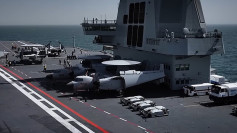According to a Wednesday report by CNBC, congestion is worsening at the Panama Canal-one of the world's major shipping arteries-with 154 vessels awaiting passage. These ships face waiting times of up to 21 days.
The Panama Canal is currently grappling with its most severe drought since records began in 1950, leading to a significant decrease in the canal's handling capacity.
In response, the Panama Canal Authority (PCA) implemented water-saving measures in late July. They temporarily reduced the booking slots for Panamax ships-the largest vessel type that can traverse the canal, capable of carrying 4,500 twenty-foot equivalent units (TEU)-from 23 to 14 daily between August 8 and 21. This reduction in slots has led to the current ship congestion.
In July, the PCA further imposed stricter lower water level limits, requiring ships to lighten their loads by 40%. This move impacted ships in transit. For instance, the "Ever Max" was forced to offload 1,400 containers at the Balboa port to meet these requirements. It is now docked at the Savannah port.
Data indicates that, during the first week of August, the average delay for ships in the Panama Canal ranged between 15 and 19 days.
Captain Adil Ashiq, the North American head of ship tracking platform Marine Traffic, noted that containers not yet offloaded might need another ship to complete the remaining journey. The situation could worsen before seeing improvement.
Each time a vessel passes through the Panama Canal, 50 million gallons of water are lost from a lock chamber. And due to the drought, Gatun Lake, which supplies water to the canal, has dropped to its lowest level in four years.
Ricaurte Vásquez Morales, the director of the Panama Canal Authority, said the canal is maintaining communication with clients, updating them promptly on available booking slots. By providing real-time information through regular updates and transparent dialogue, they aim to manage expectations and assist clients in making informed decisions.
Alan Baer, CEO of logistics company OL USA, told CNBC that shippers might have to start considering alternative routes. Given the increasing difficulties of reaching the U.S. East Coast via the Panama Canal, importers may contemplate the Suez Canal.
The Panama Canal plays a pivotal role in U.S. trade, serving as a vital route for goods destined for ports in the Gulf of Mexico and the East Coast. The U.S. is the largest user of the canal, accounting for about 73% of its traffic in terms of export and import container volume. Annually, roughly 40% of U.S. containers pass through the canal, carrying goods valued at up to $270 billion.





